Historically, there are three statistics that are looked at to evaluate and compare a goaltender: wins, goals against average (GAA) and save percentage (SV%). While they all have some merit, wins and GAA are more indicative of a team statistic. Even SV% can be skewed depending on the quality of goaltender’s team. Every statistic has pros and cons.
Several metrics will be considered here before making the final ranking and, ultimately, a Vezina Trophy selection.
Note: This article only considers goalies who played in at least 40 regular season games (approximately half a season). There were 32 goalies who qualified. Playoff performance and historical data were not factored in.
Winning is Everything
Using wins alone, Connor Hellebuyck (44), Andrei Vasilevskiy (44), Pekka Rinne (42), Frederik Andersen (38), Sergei Bobrovsky (37), and Devan Dubnyk (35) led the way. But it stands to reason that the more games played, the more opportunities there are to win. Peeling back a layer, this list takes a look at wins as a percentage of games played, a better indicator of competitive performance.
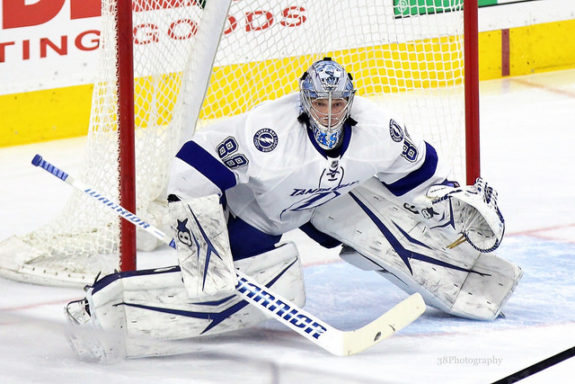
Top 10 Goalies of 2017-18: Wins as a Percentage of Games Played
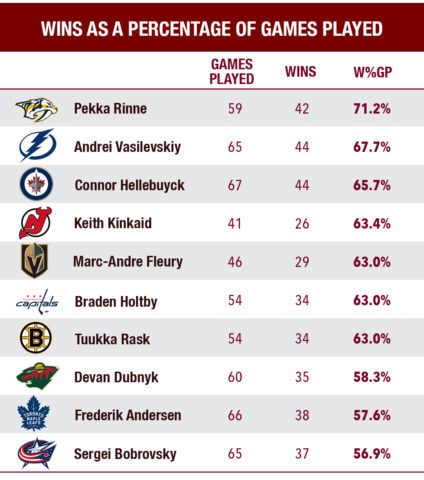
Not All Wins are the Same
While winning is all that matters, not all wins are equal. For example, a 2-1 win is different than a 5-3 win.
Grant Fuhr racked up 226 wins for the Edmonton Oilers with a goals against average of 3.69. He had the fortune of playing behind an offensive juggernaut featuring Wayne Gretzky, Jari Kurri, and Mark Messier. Not to take anything away from the five-time Stanley Cup winner, but he clearly benefitted from the offense in front of him.
For his entire NHL career, Fuhr is credited with 403 wins in 868 NHL games: a winning percentage of .464.
- Dominic Hasek 389 wins in 735 games for a winning percentage of .530.
- Patrick Roy 551 wins in 1029 games: a winning percentage of .535.
- Marty Brodeur won 691 of 1266 games: a winning percentage of .546.
Using hypothetical numbers, if Brodeur’s teams averaged 2.1 goals for and Roy’s averaged 3.2, it would suggest that Brodeur’s wins were “harder” earned.
This year, Antti Raanta of the Arizona Coyotes, played on a team that couldn’t score — they ranked 30th with 208 goals for. Raanta had a stellar season despite his team’s offensive woes. The Nashville Predators scored 55 more goals than the Yotes. Arguably, if Raanta’s team had scored 50 more, they would have won considerably more games. Raanta’s record, instead of 21-17-6 may have been about 31-7-6.
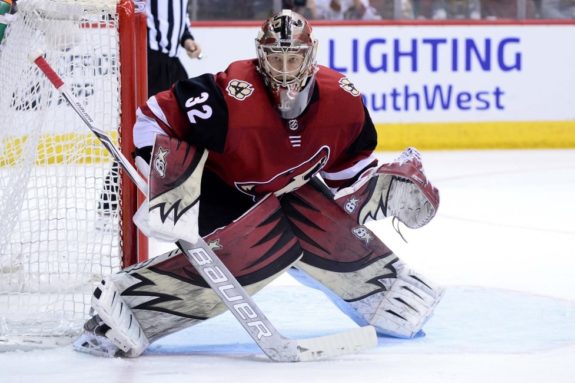
Goals Against Average
Goals against average (GAA) is hard-wired into our brains to be important. And it is, to an extent — the basis of the game relies on keeping the puck out of the net and scoring on the other one.
These are the top ten goaltender’s GAA during the entire 2017-18 regular season:
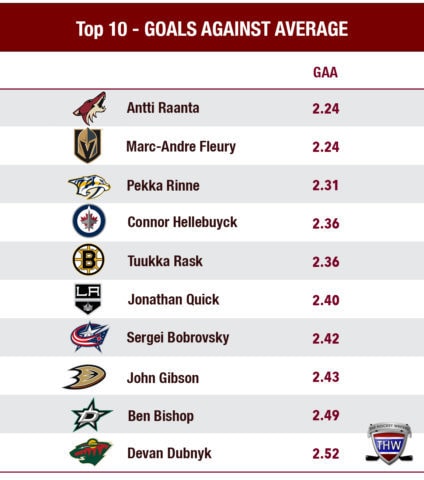
However, goals against average is altered by a variety of factors, and is actually more of a team statistic. Goaltenders have no control over how many shots are taken at them. They have little-to-no control over how many penalties their teams take. And they have little control over where the shots they face are coming from, or how plays develop. Yet all of these points, to varying degrees, have an impact on a goaltender’s GAA. Collectively, the team influences those things.
Shots Faced and Save Percentages
A goalie is a team’s last line of defense. Whether a shot comes from the point, the top of the faceoff circle or the slot, his job is to stop it. Since defenses vary from team to team, we looked at how much rubber each goalie faced per game.

These are the top goaltenders who faced the most shots during the entire 2017-18 regular season:
Top 10 Goalies of 2017-18: Total Shot Faced
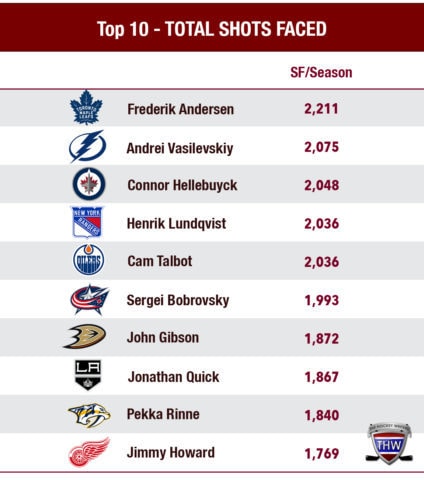
Top 10 Goalies of 2017-18: Average Shots Faced Per Game
Here’s a look at the top ten highest average shots faced per game:
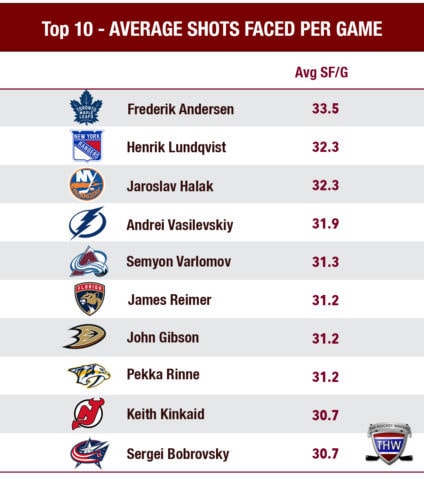
Here’s a look at the top save percentages:
Top 10 Goalies of 2017-18: Save Percentages
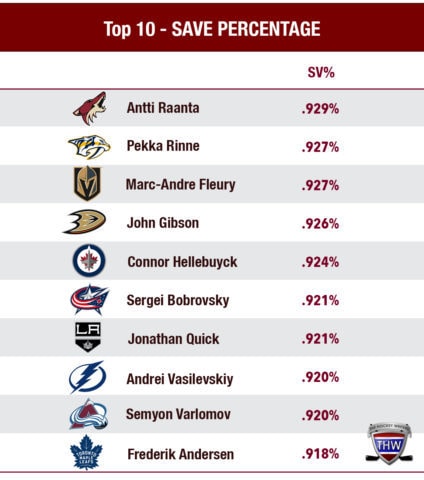
Of the top ten goalie save percentages, seven also made the list of most shots faced. With that in mind, it’s reinforces the hypothesis that busy goalies may be sharper than those that see fewer shots.
Modern Goalie Metrics
Another relatively new statistic is a goalies’ Goals Saved Above Average (GSAA). It is the goals a goalie prevents given his save percentage and shots faced vs. the league average save percentage on the same number of shots. The higher the number, the better they performed compared to a league-average goalie.
While there were no runaway leaders for this metric, there were four netminders that rose to the top: Rinne, Gibson, Raanta and Hellebuyck.
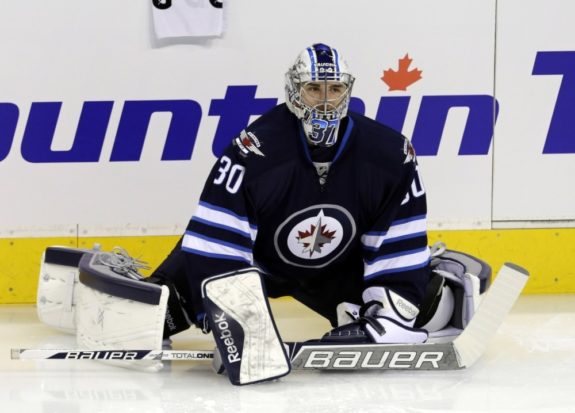
Top 10 Goalies of 2017-18: Goals Saved Above Average
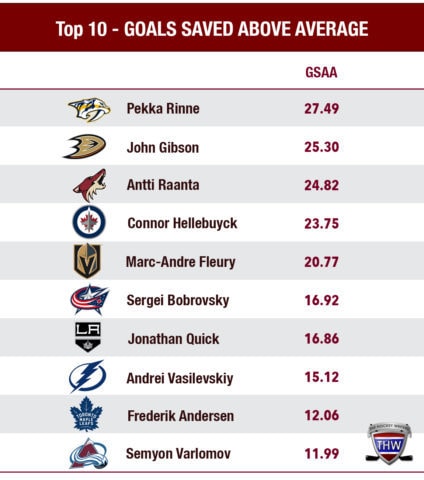
Top 10 Goalies of 2017-18 – Quality Start Percentage
Finally, there’s the metric of Quality Starts Percentage (QS%). A Quality Start (QS) is similar to saying a goaltender ‘gave his team a chance to win.’ In order to record a Quality Start, the starting goalie must have a save percentage in a game that is greater than the average save percentage of a starting goalie for the year. If a goalie faces 20 or fewer shots, he only needs to record an 88.5% save percentage.
The Quality Start Percentage (QS%) is simply the number of Quality Starts divided by the number of games started. For this stat, anything over .600 percent is considered excellent. Statistically, Raanta, Rinne and Fleury were in a whole ‘nother stratosphere.

The Best Goalies of 2017-18
For the categories of Wins as a Percentage of Games Played, Save Percentage, Goals Against Average, GSAA and QS%, this top 10 list assigns a weighted system: 40 points for first place, 38 points for second, 36 points for third and so on; then 19 points for 11th place, 18 points for 12th place, 17 points for 13th place, etc.
Top 10 Goalies of 2017-18 – Weighted Categories
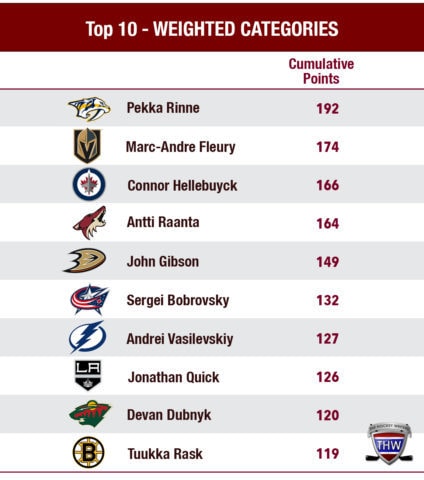
Using this ranking system, it’s clear there are several goalies that rose above the others. Rinne, Fleury, Hellebuyck, Raanta and Gibson led the way.
Upon further observation, it’s interesting to note:
- All five of these goalies play in the Western Conference. Only three of the top ten are from the Eastern Conference.
- Raanta led the league in both SV% and GAA, but won less than half of his games played (21 of 47). Again, it’s unfortunate the Coyotes didn’t offer up more offense.
- Rinne and Vasilevskiy both tied for the league lead with eight shutouts each, Hellebuyck was next with six.
- Ben Bishop and Frederik Andersen were the only goalies with five or more shutouts that failed to crack this Top 10 List.
Top 10 Goaltenders (Weighted) with Team Goal Differential
From a team perspective, the Lightning (plus-60), Jets (plus-59), Bruins (plus-56), Preds (plus-56) and Golden Knights (plus-44) had the League’s best team goal differential. All four of these teams’ goalies are among the top 10 Weighted List. However, the Kings (plus-36), Ducks (plus-19), Blue Jackets (plus-12), Wild (plus-21) were among the next tier. Their lower differential suggest their games were typically closer, putting even more pressure on the goalies to make a key save.
A complete and baffling outlier are the Coyotes that had a whopping minus-48 goal differential. It further points to the need for a major upgrade in offense and goal support for Rannta, who was among the best goaltenders of the regular season.
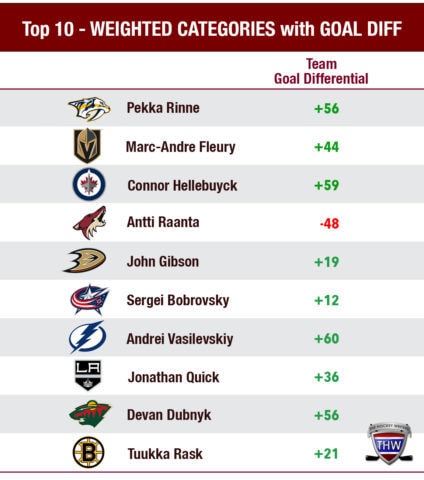
Vezina Trophy
All three of the NHL’s Vezina Trophy finalists had incredible years. Hellebuyck, Vasilevskiy and Rinne were all dominant, earning 130 wins between them. With all due respect to those three, honorable mentions are also in order for Rannta, Fleury, Gibson and Bobrovsky.
Vasilevskiy, with 44 wins, helped the Lighting to the best record in the Eastern Conference and the best season in their history. The 23-year-old is in his fourth year in the league.
Hellebuyck, only a 24-year-old, also earned 44 wins, breaking Tom Barrasso’s record for most wins by a United States-born goaltender.
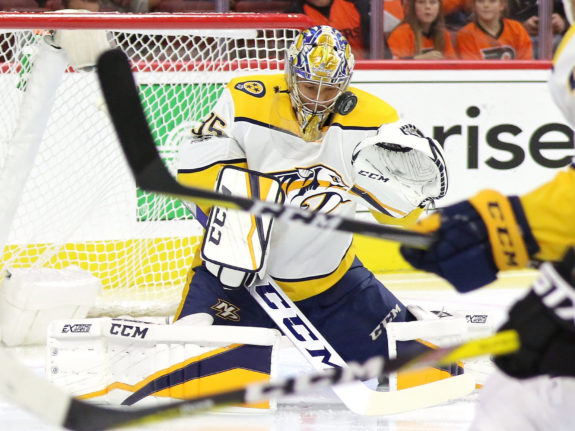
The Vezina Trophy should go to Pekka Rinne. While he played in 59 games, fewer than many other top-end starters, he still finished third in wins (42) and first in shutouts (8) to help lead the Predators to the first Presidents’ Trophy in franchise history. Finally, after finishing second in 2010-11 and 2014-15, and third in 2011-12, the 35-year-old native of Finland should take home his first Vezina.